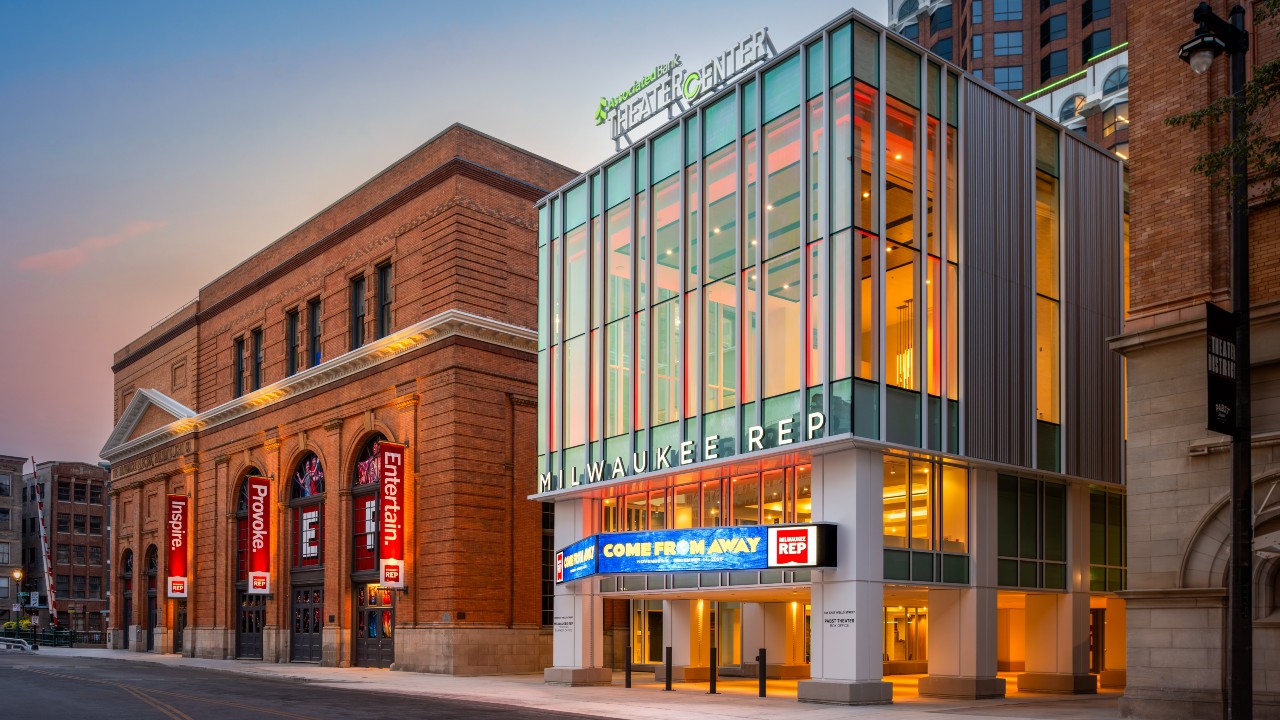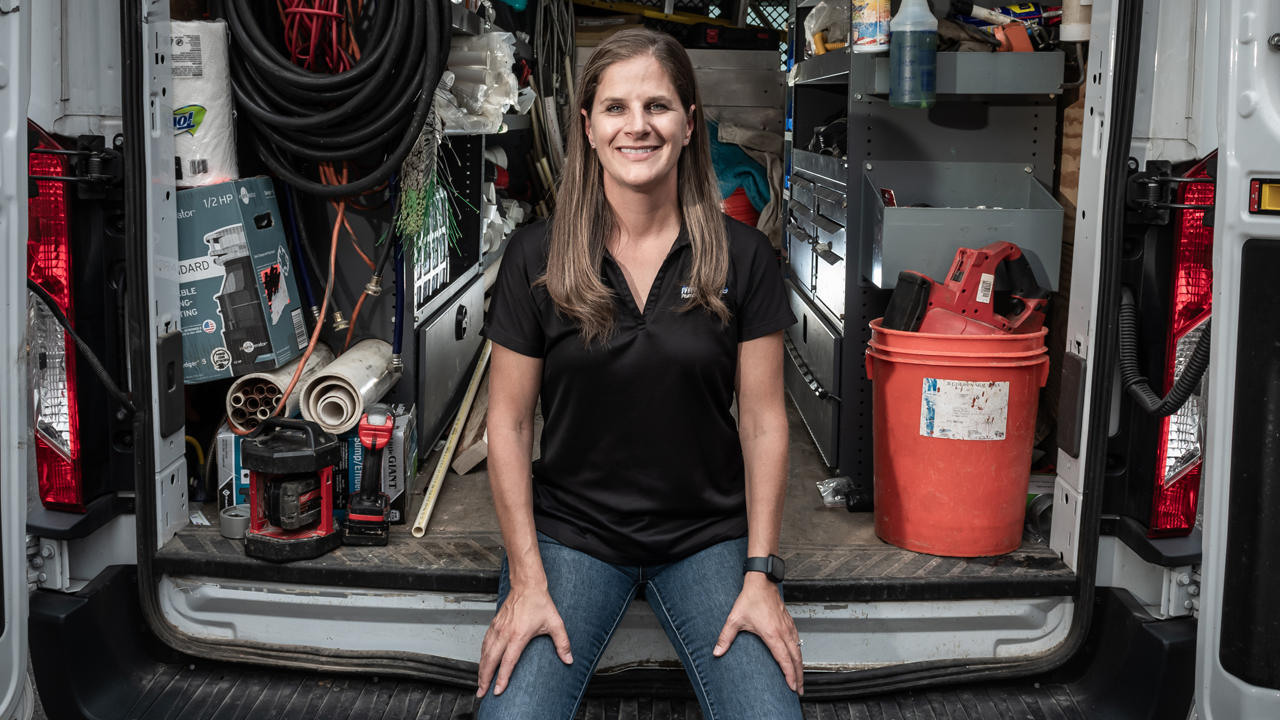For decades, the Milwaukee Repertory Theater has stood as a leader in the city’s vast arts and culture landscape.
But other venues, such as the Bradley Symphony Center and the Milwaukee Ballet’s Baumgartner Center for Dance, have offered more comfortable and comprehensive experiences for audiences. The Milwaukee Rep was “losing ground,” Milwaukee Rep executive director Chad Bauman said.
“We could not be competitive in that field, because we didn’t have the same sort of audience comforts and offerings,” Bauman said.
That is all about to change as the Milwaukee Rep prepares to open its $80 million Associated Bank Theater Center on Oct. 11. A 152,500-square-foot facility built in the same space as the Rep’s Patty & Jay Baker Theater Complex at 108 E. Wells St. in downtown Milwaukee, the Associated Bank Theater Center offers greater accessibility, comfortable seating, updated theatrical technology and more elements to provide an elevated experience for audience members.
The Milwaukee Repertory Theater’s Associated Bank Theater Center. Photo credit: Peter McCullough Photo + Drone
The project, which broke ground last year, transformed the Ellen and Joe Checota Powerhouse Theater; constructed the 2,700-square-foot Herzfeld Foundation Education & Engagement Center; and connected the Rep’s auditoriums through the new Sandra & William Haack Galleria, which includes gathering spaces, accessible restrooms, a gift shop and bars.
A second phase of the project — scheduled to be completed in February — will also renovate the Herro-Franke studio and administrative offices.
“We’re going to be able to attract audiences now that are looking for a full, robust and exceptional experience,” Bauman said. “I think audiences are looking for that full experience, and they can have it here for the first time.”
Resilience amid daunting circumstances for Milwaukee Rep
Since embarking on the Associated Bank Theater Center project, the theater company has survived a global pandemic, supply chain issues, labor shortages, high inflation, tariffs and most recently a “once in a thousand years” flooding event that affected its Wauwatosa production facility.
On Aug. 10, historic rainfall filled the Rep’s production facility with several feet of water, destroying equipment, props and other production pieces. It was a “catastrophic loss” totaling about $7.5 million worth of damages, Bauman said.

“We had to make a decision,” Bauman said. “It was eight weeks out from the building opening. Are we going to postpone or delay? And if not, what are we going to do? The immediate decision was no, we’re not going to delay the opening. We’re not going to postpone the opening.”
The Rep also overcame strained philanthropic resources and a lack of public funding to achieve its $78 million fundraising goal last year. The Rep first announced the Powering Milwaukee Capital Campaign to renovate its theater space in February 2020, but the effort stalled when the COVID-19 pandemic broke out in March 2020.
The initial plan for the project included a $60 million price tag. By the time the campaign relaunched in 2021, inflation rates required the campaign goal to be increased to $75 million. Due to additional inflation, that was eventually increased to $78 million.
“It’s been one thing after another, after another, after another, and it’s sort of miraculous that this building is opening,” Bauman said. “And yet with all of that, this building is opening on time, on budget and fully funded.”

The Rep ultimately raised $80.1 million toward the project, including $1.9 million in state funding. The Rep reached its $78 million campaign goal purely through private donations. Nearly 600 donors contributed to the campaign, which received significant donations from Associated Bank, Ellen and Joe Checota, Sandra and William Haack, and many more individuals and organizations.
The organization’s legacy, spanning generations of people who first attended as children, made the goal seem attainable, said Chuck Rozewicz, chief development officer at the Milwaukee Rep.
“I’m not going to say it wasn’t daunting when you use a number like $78 million, but we had a feeling that there were enough people that really cared about the work that we were doing and how we were contributing to the community,” Rozewicz said.
The Rep’s team at all levels has exhibited resilience and creativity “each time they faced a daunting challenge,” Bauman said.
“We have sort of a mantra, it’s an old one, that the show must go on,” he said. “We just persevere, and we adapt. We’ve gotten really good at that. We have great support. We’re very creative. And we’ve just pushed through it.”
Navigating Associated Bank Theater Center construction challenges
The historic building that the Milwaukee Rep calls home was previously used as a power plant before the theater company moved there in 1987. The Milwaukee Rep first started planning a facility renovation project in 2018 when there were two major indicators that the company needed to address its aging facility, Bauman said.
There was an elevator fire — caused by an outdated part that replacements no longer existed for — and a piece of the building structure overhanging Water Street fell off and almost hit someone. A subsequent facility audit revealed that a full overhaul of the space was necessary for the theater to continue.
The Rep went on to partner with Brookfield-based Hunzinger Construction for the Associated Bank Theater Center project. Hunzinger Construction was also the Rep’s construction partner when the theater renovated the Stackner Cabaret in 2018.
John Hunzinger, chairman and CEO of Hunzinger Construction and a former Milwaukee Rep board member, said it is typical for there to be both anticipated and discovered challenges during a renovation project for a historic building. When Hunzinger began working on the site for the Associated Bank Theater Center, the team discovered some unique challenges.
When digging underneath the lobby space to prepare for the foundation work, the team discovered an abandoned electrical vault. They also found pieces of the old cobblestone street that used to run through that space.
“The hard thing with (the electrical vault) was that they couldn’t just go in with an excavator and pull it out because the electrical vault was right up against the back wall of our current electrical vault route,” said Melissa Vartanian-Mikaelian, managing director of the Milwaukee Rep. “That wall was deteriorating, and there was some effervescence on it. It needed some work and it was in a fragile state. As they got in there, they couldn’t just come in and excavate it. They literally had to excavate it by hand.”
The project also presented geotechnical challenges, Hunzinger said. The Hunzinger team was working on “unsuitable soil” and needed to complete excavation and deep foundation solutions.
When creating new passageways within the structure, the team encountered many brick walls that were at least three feet thick.
Vartanian-Mikaelian said the process of tearing out the third floor dressing rooms to create space presented some engineering and structural challenges as well.
“As they were tearing out that area, there were also areas that used to be part of the old historic power plant that had just been capped off and were no longer needed,” Vartanian-Mikaelian said. “They had just been closed in. Big concrete masses had to be removed. Some of them were filled with very old ash, and they had to have that remediated and make sure that that was taken care of in a way that was safe for everyone.”
Inside the Checota Powerhouse Theater, the catwalk was removed and rebuilt to accommodate the stage’s new ability to serve as either a thrust or proscenium.
“A lot of engineering had to go into that platforming system that holds the stage floor up,” Vartanian-Mikaelian said.
With all of the unexpected challenges the team encountered, it’s easy to imagine extending the timeline of the project and delaying the grand opening of the Associated Bank Theater Center.
However, the Hunzinger team would resequence parts of the project when they ran into a new obstacle.
“It was like they were spinning plates all the time, resequencing things, and making sure we could keep moving,” Vartanian-Mikaelian said. “Where we were losing time, they would try to make up time by maybe pushing forward on the part of the project that wasn’t meant to happen at that point, but they had the opportunity to do it.”
Hunzinger expects that by the time the project is complete, there will have been about 300,000 man hours worked on the site.
“We’re really making sure that folks feel like they can come to our theater and that we’ve been thoughtful about that process along the way,” Vartanian-Mikaelian said.
Providing an elevated experience for Milwaukee theater audiences
When a guest arrives at the Milwaukee Rep’s Associated Bank Theater Center, they are welcomed with valet parking and a glass atrium entrance that allows access to all three auditoriums.
Once inside, guests can take elevators wherever they need to go. The Checota Powerhouse Theater offers comfortable seating akin to aircraft seats, artistic director Mark Clements said.
Accessibility improvements have been made inside the facility, including within the Checota Powerhouse Theater.
“For a lot of people who start developing mobility issues in later life, their desire to go to the theater does not stop,” Clements said. “The accessibility and the experience and the difficulties previously in our spaces were a problem. Now that’s going to be significantly different.”
For audience members who used a wheelchair, Rep staff would have to unbolt a seat at the back of the auditorium to make space for the wheelchair, Clements said.
“It wasn’t ideal,” Clements said. “Now, in between the front portion of the seating and the middle portion, there’ll be a possibility to put in a wheelchair there. Everybody gets the same experience, and being able to get out will be much easier if people need to.”
For audiences watching a show at the Milwaukee Rep’s new Associated Bank Theater Center, “the experience is going to be extremely elevated in terms of what you can see,” Clements said.
The stage offers improved lighting, sound and the capability to fly in scenery.
Planning for The Rep’s future
The Rep — which has grown from a $14 million company to a $17 million company in the last couple of years — will be able to better accommodate its growing audiences with this new facility, Bauman said.
“The facility itself will allow us to attract more customers, and with more customers, the company becomes financially stronger,” Bauman said. “A financially stronger company will be able to take more artistic risk and create better productions that our customers will see.”
The state-of-the-art facility means there is more capability to focus on ramping up the theater company’s development of new productions, which Clements says is his priority when looking to the Rep’s future.
“I have often said to our stakeholders that the difference between a very good theater and an excellent theater can sometimes be defined by the new work, that it’s commissioning, incubating, developing, and ultimately producing,” Clements said.
The Rep will be able to tour those productions around the country and internationally, as well as send them onto Broadway.
The new complex also allows the Rep greater opportunity to work with more theater companies, Clements said.

With the new Herzfeld Foundation Education & Engagement Center, the Milwaukee Rep will expand its education services for young children, teenagers and adults. The Rep relocated its production space from the first level of its theater complex to Wauwatosa, and that transition opened up space at the Associated Bank Theater Center for its education programs to be located in-house.
“In the next couple of years, we’re looking at expanding and serving more than 30,000 students, and that’s going to be really impactful when it comes to the arts education experiences that students have in the region,” Bauman said.
Clements said that at a time when resources for some public schools in Milwaukee are declining, the Rep has a responsibility to help bridge the gap.
“I think a commonality of most of our donors and stakeholders will be, we were taken to the theater by our parents when we were kids, and we feel more rounded (as) human beings as a result of being exposed to the live arts,” Clements said.
Building ‘the people’s theater’ in Milwaukee
About a week before speaking with BizTimes, Bauman sat in the seats of the Checota Powerhouse Theater for the first time.
“It’s a very different experience when you’re picking color swatches and fabrics and it all seems to be a little abstract,” Bauman said. “When you can actually go into the space and sit in the seats and experience what our customers are about to experience — I had a visceral reaction. I had goosebumps, and it took my breath away. I think it’s going to do that for our community as well.”
William Haack, a co-chair of the Rep’s capital campaign, along with his wife, Sandra, donated $2.5 million to the project. He and his wife contributed to what he described as a “generational project” because of what the Rep means for Milwaukee.
“It’s important for the Milwaukee community in order to remain a world-class city,” said Haack, who is also founder and former CEO of Zywave. “Theater is something that I think is very important.”
Associated Bank also contributed to the project because the company wanted to help the Rep bring “the transformative and connective power of great storytelling” to Milwaukee, said Bryan Carson, chief product and marketing officer at Associated Bank.
Clements often jokes that he wants the Milwaukee Rep to be the theatrical version of the Green Bay Packers, the only community-owned NFL team.
Outside of the $1.9 million from the state, the Associated Bank Theater Center has been funded through private philanthropy.
“There were some very big donors in there, but also there were people who gave $100,” Clements said. “It’s our theater. Even if you didn’t give anything, and you’re just a subscriber or a single ticket buyer, it’s Milwaukee’s theater. I look at it like the people’s theater. I want people to have a real sense of ownership at all levels.”
Author
-

Elizabeth Morin is a writer based in Virginia Beach. She is passionate about local sports, politics and everything in between.
Have any Virginia Beach-related news published on our website? Email us at admin at thevirginiabeachobserver.com.
View all posts



